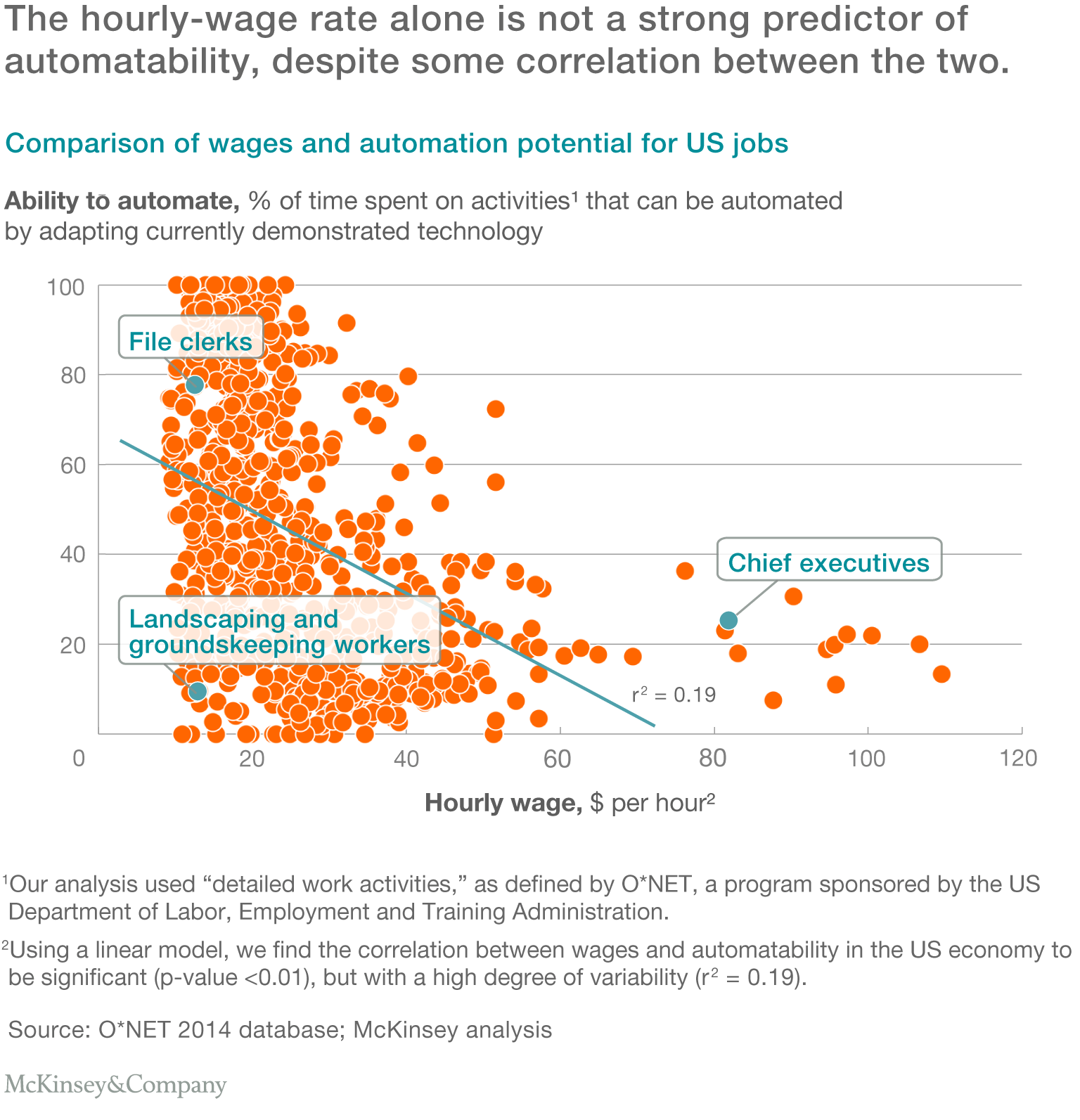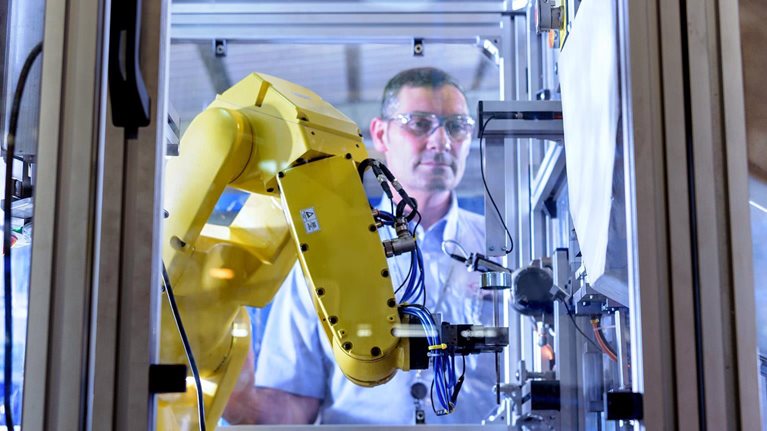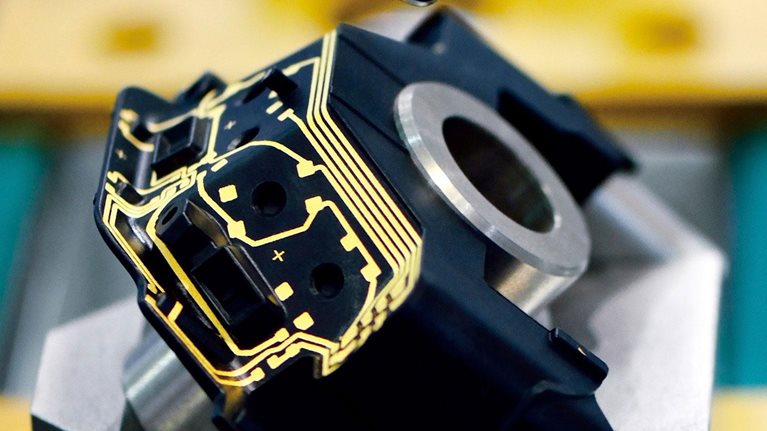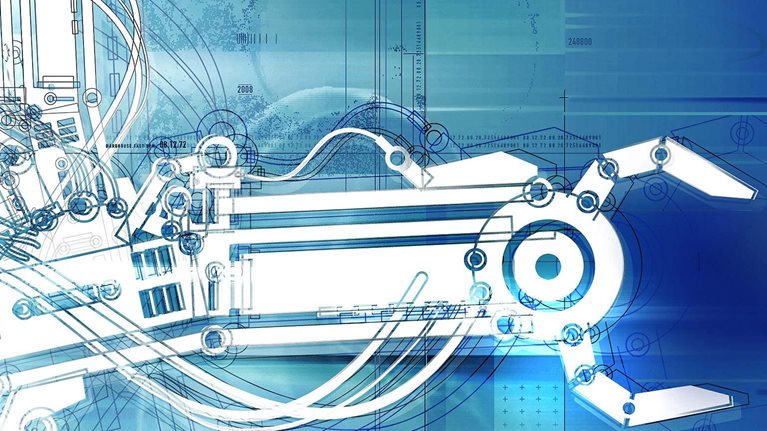The potential of artificial intelligence and advanced robotics to perform tasks once reserved for humans is no longer reserved for spectacular demonstrations by the likes of IBM’s Watson, Rethink Robotics’ Baxter, DeepMind, or Google’s driverless car. Just head to an airport: automated check-in kiosks now dominate many airlines’ ticketing areas. Pilots actively steer aircraft for just three to seven minutes of many flights, with autopilot guiding the rest of the journey. Passport-control processes at some airports can place more emphasis on scanning document bar codes than on observing incoming passengers.
What will be the impact of automation efforts like these, multiplied many times across different sectors of the economy?1 Can we look forward to vast improvements in productivity, freedom from boring work, and improved quality of life? Should we fear threats to jobs, disruptions to organizations, and strains on the social fabric?2
Earlier this year, we launched research to explore these questions and investigate the potential that automation technologies hold for jobs, organizations, and the future of work.3 Our results to date suggest, first and foremost, that a focus on occupations is misleading. Very few occupations will be automated in their entirety in the near or medium term. Rather, certain activities are more likely to be automated, requiring entire business processes to be transformed, and jobs performed by people to be redefined, much like the bank teller’s job was redefined with the advent of ATMs.
More specifically, our research suggests that as many as 45 percent of the activities individuals are paid to perform can be automated by adapting currently demonstrated technologies.4 In the United States, these activities represent about $2 trillion in annual wages. Although we often think of automation primarily affecting low-skill, low-wage roles, we discovered that even the highest-paid occupations in the economy, such as financial managers, physicians, and senior executives, including CEOs, have a significant amount of activity that can be automated.
The organizational and leadership implications are enormous: leaders from the C-suite to the front line will need to redefine jobs and processes so that their organizations can take advantage of the automation potential that is distributed across them. And the opportunities extend far beyond labor savings. When we modeled the potential of automation to transform business processes across several industries, we found that the benefits (ranging from increased output to higher quality and improved reliability, as well as the potential to perform some tasks at superhuman levels) typically are between three and ten times the cost. The magnitude of those benefits suggests that the ability to staff, manage, and lead increasingly automated organizations will become an important competitive differentiator.
Our research is ongoing, and in 2016, we will release a detailed report. What follows here are four interim findings elaborating on the core insight that the road ahead is less about automating individual jobs wholesale, than it is about automating the activities within occupations and redefining roles and processes.
1. The automation of activities
These preliminary findings are based on data for the US labor market. We structured our analysis around roughly 2,000 individual work activities,5 and assessed the requirements for each of these activities against 18 different capabilities that potentially could be automated (Exhibit 1). Those capabilities range from fine motor skills and navigating in the physical world, to sensing human emotion and producing natural language. We then assessed the “automatability” of those capabilities through the use of current, leading-edge technology, adjusting the level of capability required for occupations where work occurs in unpredictable settings.

The bottom line is that 45 percent of work activities could be automated using already demonstrated technology. If the technologies that process and “understand” natural language were to reach the median level of human performance, an additional 13 percent of work activities in the US economy could be automated. The magnitude of automation potential reflects the speed with which advances in artificial intelligence and its variants, such as machine learning, are challenging our assumptions about what is automatable. It’s no longer the case that only routine, codifiable activities are candidates for automation and that activities requiring “tacit” knowledge or experience that is difficult to translate into task specifications are immune to automation.
In many cases, automation technology can already match, or even exceed, the median level of human performance required. For instance, Narrative Science’s artificial-intelligence system, Quill, analyzes raw data and generates natural language, writing reports in seconds that readers would assume were written by a human author. Amazon’s fleet of Kiva robots is equipped with automation technologies that plan, navigate, and coordinate among individual robots to fulfill warehouse orders roughly four times faster than the company’s previous system. IBM’s Watson can suggest available treatments for specific ailments, drawing on the body of medical research for those diseases.
2. The redefinition of jobs and business processes
According to our analysis, fewer than 5 percent of occupations can be entirely automated using current technology. However, about 60 percent of occupations could have 30 percent or more of their constituent activities automated. In other words, automation is likely to change the vast majority of occupations—at least to some degree—which will necessitate significant job redefinition and a transformation of business processes. Mortgage-loan officers, for instance, will spend much less time inspecting and processing rote paperwork and more time reviewing exceptions, which will allow them to process more loans and spend more time advising clients. Similarly, in a world where the diagnosis of many health issues could be effectively automated, an emergency room could combine triage and diagnosis and leave doctors to focus on the most acute or unusual cases while improving accuracy for the most common issues.
As roles and processes get redefined, the economic benefits of automation will extend far beyond labor savings. Particularly in the highest-paid occupations, machines can augment human capabilities to a high degree, and amplify the value of expertise by increasing an individual’s work capacity and freeing the employee to focus on work of higher value. Lawyers are already using text-mining techniques to read through the thousands of documents collected during discovery, and to identify the most relevant ones for deeper review by legal staff. Similarly, sales organizations could use automation to generate leads and identify more likely opportunities for cross-selling and upselling, increasing the time frontline salespeople have for interacting with customers and improving the quality of offers.
3. The impact on high-wage occupations
Conventional wisdom suggests that low-skill, low-wage activities on the front line are the ones most susceptible to automation. We’re now able to scrutinize this view using the comprehensive database of occupations we created as part of this research effort. It encompasses not only occupations, work activities, capabilities, and their automatability, but also the wages paid for each occupation.6
Our work to date suggests that a significant percentage of the activities performed by even those in the highest-paid occupations (for example, financial planners, physicians, and senior executives) can be automated by adapting current technology.7 For example, we estimate that activities consuming more than 20 percent of a CEO’s working time could be automated using current technologies. These include analyzing reports and data to inform operational decisions, preparing staff assignments, and reviewing status reports. Conversely, there are many lower-wage occupations such as home health aides, landscapers, and maintenance workers, where only a very small percentage of activities could be automated with technology available today (Exhibit 2).

4. The future of creativity and meaning
Capabilities such as creativity and sensing emotions are core to the human experience and also difficult to automate. The amount of time that workers spend on activities requiring these capabilities, though, appears to be surprisingly low. Just 4 percent of the work activities across the US economy require creativity at a median human level of performance. Similarly, only 29 percent of work activities require a median human level of performance in sensing emotion.

Could a machine do your job?
Explore our comprehensive data set on Tableau Public.
While these findings might be lamented as reflecting the impoverished nature of our work lives, they also suggest the potential to generate a greater amount of meaningful work. This could occur as automation replaces more routine or repetitive tasks, allowing employees to focus more on tasks that utilize creativity and emotion. Financial advisors, for example, might spend less time analyzing clients’ financial situations, and more time understanding their needs and explaining creative options. Interior designers could spend less time taking measurements, developing illustrations, and ordering materials, and more time developing innovative design concepts based on clients’ desires.
These interim findings, emphasizing the clarity brought by looking at automation through the lens of work activities as opposed to jobs, are in no way intended to diminish the pressing challenges and risks that must be understood and managed. Clearly, organizations and governments will need new ways of mitigating the human costs, including job losses and economic inequality, associated with the dislocation that takes place as companies separate activities that can be automated from the individuals who currently perform them. Other concerns center on privacy, as automation increases the amount of data collected and dispersed. The quality and safety risks arising from automated processes and offerings also are largely undefined, while the legal and regulatory implications could be enormous. To take one case: who is responsible if a driverless school bus has an accident?
Nor do we yet have a definitive perspective on the likely pace of transformation brought by workplace automation. Critical factors include the speed with which automation technologies are developed, adopted, and adapted, as well as the speed with which organization leaders grapple with the tricky business of redefining processes and roles. These factors may play out differently across industries. Those where automation is mostly software based can expect to capture value much faster and at a far lower cost. (The financial-services sector, where technology can readily manage straight-through transactions and trade processing, is a prime example.) On the other hand, businesses that are capital or hardware intensive, or constrained by heavy safety regulation, will likely see longer lags between initial investment and eventual benefits, and their pace of automation may be slower as a result.
All this points to new top-management imperatives: keep an eye on the speed and direction of automation, for starters, and then determine where, when, and how much to invest in automation. Making such determinations will require executives to build their understanding of the economics of automation, the trade-offs between augmenting versus replacing different types of activities with intelligent machines, and the implications for human skill development in their organizations. The degree to which executives embrace these priorities will influence not only the pace of change within their companies, but also to what extent those organizations sharpen or lose their competitive edge.


